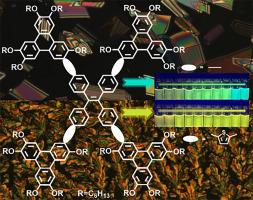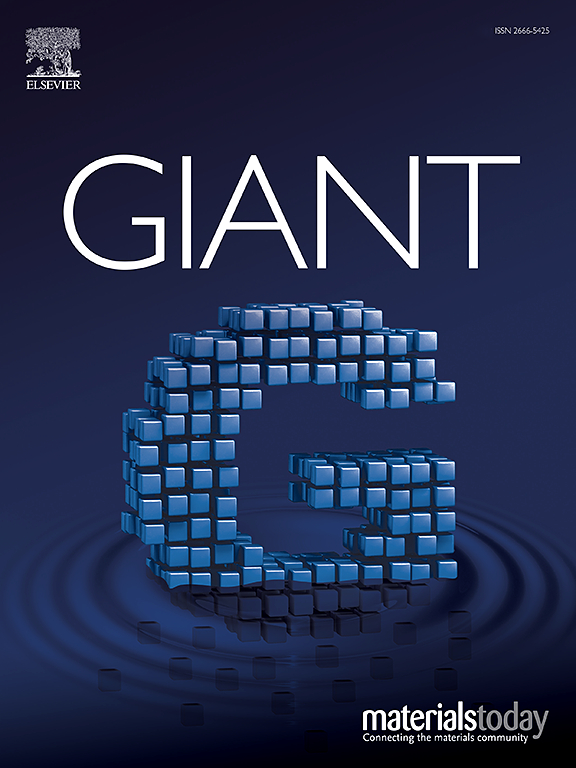Combining discotic mesogens with AIE luminogens for advanced optoelectronic applications: Design, synthesis, mesomorphism, self-assembly and optical properties of tetraphenylethylene-triphenylene oligomeric conjugates
IF 4.9
1区 化学
Q2 CHEMISTRY, MULTIDISCIPLINARY
引用次数: 0
Abstract
The combination of different molecular entities with their own and specific functionalities within a single molecule enables the generation of potentially original multifunctional materials with unique properties and a broad range of applications across various fields. In this work, tetraphenylethylene (TPE) and triphenylene (TP) molecules are combined within a single oligomeric structure to yield original mesomorphic materials: TPE was chosen for its exceptional optical properties (AIE—aggregation-induced emission), while TP was included to ensure columnar self-assembly and mesomorphism. Two tetraphenylethylene-triphenylene tetrads, TPE-TP4 and TPE-ThTP4, with a crossed-shaped molecular structure, with the central TPE connecting 4 radial TP subunits, have been synthesized by the Suzuki-Miyaura coupling reaction. Both compounds exhibit high thermal stability, above 340°C. While TPE-TP4 shows only crystalline behaviour before reversibly melting into the isotropic liquid, TPE-ThTP4, which includes an additional thiophene ring bridging the central TPE and the peripheral TPs, exhibits a rectangular “multicolumnar” phase (Colrec), over a large temperature range of approximately 300°C. They also both self-assemble in fibers when mixed in various solvents to form organic gels. UV-visible absorption and fluorescence emission spectra reveal that both compounds have strong fluorescence properties in solutions and thin films, with emission wavelengths ranging between 460 and 550 nm. The absolute emission quantum yield is highly solvent-dependent, reaching a maximum of 84.5 % in cyclohexane. These tetrameric compounds also present aggregation-induced emission behaviour with a significant enhancement of the fluorescence intensity. Overall, the combination of discotic mesogens and AIE-gens within a single molecular framework holds great promises for the development of next-generation optoelectronic materials.

结合盘状介源与AIE发光源用于先进光电应用:四苯乙烯-三苯乙烯寡聚物的设计、合成、介形、自组装和光学性质
在单个分子中结合不同的分子实体和它们自己的特定功能,可以产生具有独特性能和广泛应用于各个领域的潜在原始多功能材料。在这项工作中,四苯基乙烯(TPE)和三苯基乙烯(TP)分子结合在一个单一的低聚结构中,产生原始的介形材料:选择TPE是因为其特殊的光学性质(ae -聚集诱导发射),而包括TP是为了确保柱状自组装和介形。采用Suzuki-Miyaura偶联反应合成了两种分子结构呈十字状的四苯乙烯-三苯四聚体TPE- tp4和TPE- thtp4,其中心TPE连接4个径向TP亚基。这两种化合物都具有很高的热稳定性,在340°C以上。虽然TPE- tp4在可逆熔化成各向同性液体之前仅表现出结晶行为,但TPE- thtp4在大约300°C的大温度范围内表现出矩形的“多柱”相(Colrec), TPE- thtp4包括一个额外的噻吩环,桥接中心TPE和外围TPs。当它们在各种溶剂中混合形成有机凝胶时,它们也会在纤维中自组装。紫外可见吸收光谱和荧光发射光谱显示,这两种化合物在溶液和薄膜中都具有较强的荧光特性,发射波长在460 ~ 550 nm之间。绝对发射量子产率高度依赖于溶剂,在环己烷中最高可达84.5%。这些四聚体化合物也表现出聚集诱导的发射行为,荧光强度显著增强。总的来说,盘状中原和ae -原在单一分子框架内的结合为下一代光电材料的发展带来了巨大的希望。
本文章由计算机程序翻译,如有差异,请以英文原文为准。
求助全文
约1分钟内获得全文
求助全文
来源期刊

GIANT
Multiple-
CiteScore
8.50
自引率
8.60%
发文量
46
审稿时长
42 days
期刊介绍:
Giant is an interdisciplinary title focusing on fundamental and applied macromolecular science spanning all chemistry, physics, biology, and materials aspects of the field in the broadest sense. Key areas covered include macromolecular chemistry, supramolecular assembly, multiscale and multifunctional materials, organic-inorganic hybrid materials, biophysics, biomimetics and surface science. Core topics range from developments in synthesis, characterisation and assembly towards creating uniformly sized precision macromolecules with tailored properties, to the design and assembly of nanostructured materials in multiple dimensions, and further to the study of smart or living designer materials with tuneable multiscale properties.
 求助内容:
求助内容: 应助结果提醒方式:
应助结果提醒方式:


